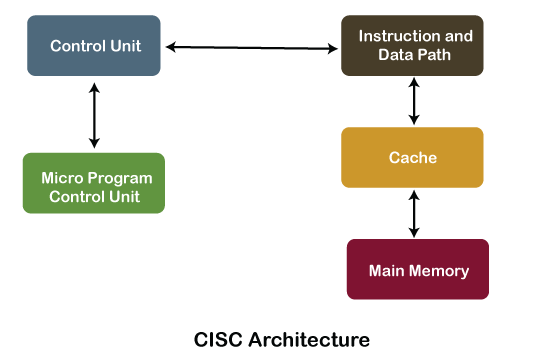CISC Processor
The CISC Stands for Complex Instruction Set Computer, developed by the Intel. It has a large collection of complex instructions that range from simple to very complex and specialized in the assembly language level, which takes a long time to execute the instructions. So, CISC approaches reducing the number of instruction on each program and ignoring the number of cycles per instruction. It emphasizes to build complex instructions directly in the hardware because the hardware is always faster than software. However, CISC chips are relatively slower as compared to RISC chips but use little instruction than RISC. Examples of CISC processors are VAX, AMD, Intel x86 and the System/360.
Characteristics of CISC Processor
Following are the main characteristics of the RISC processor:
- The length of the code is shorts, so it requires very little RAM.
- CISC or complex instructions may take longer than a single clock cycle to execute the code.
- Less instruction is needed to write an application.
- It provides easier programming in assembly language.
- Support for complex data structure and easy compilation of high-level languages.
- It is composed of fewer registers and more addressing nodes, typically 5 to 20.
- Instructions can be larger than a single word.
- It emphasizes the building of instruction on hardware because it is faster to create than the software.
CISC Processors Architecture
The CISC architecture helps reduce program code by embedding multiple operations on each program instruction, which makes the CISC processor more complex. The CISC architecture-based computer is designed to decrease memory costs because large programs or instruction required large memory space to store the data, thus increasing the memory requirement, and a large collection of memory increases the memory cost, which makes them more expensive.

Advantages of CISC Processors
- The compiler requires little effort to translate high-level programs or statement languages into assembly or machine language in CISC processors.
- The code length is quite short, which minimizes the memory requirement.
- To store the instruction on each CISC, it requires very less RAM.
- Execution of a single instruction requires several low-level tasks.
- CISC creates a process to manage power usage that adjusts clock speed and voltage.
- It uses fewer instructions set to perform the same instruction as the RISC.
Disadvantages of CISC Processors
- CISC chips are slower than RSIC chips to execute per instruction cycle on each program.
- The performance of the machine decreases due to the slowness of the clock speed.
- Executing the pipeline in the CISC processor makes it complicated to use.
- The CISC chips require more transistors as compared to RISC design.
- In CISC it uses only 20% of existing instructions in a programming event.




No comments:
Post a Comment